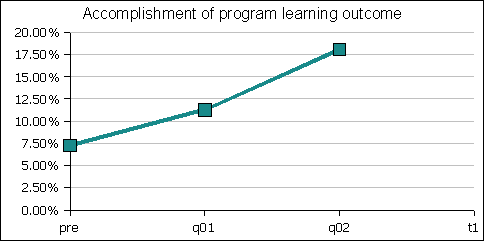| Src |
Q |
Description |
l |
Outref |
SLO |
Corr |
Corr% |
| Pre |
P1 |
level
of measure |
1 |
1 |
Calculate basic statistics |
2 |
5% |
| Pre |
P2 |
sample
size |
1 |
1 |
Calculate basic statistics |
5 |
12% |
| Pre |
P3 |
mean |
1 |
1 |
Calculate basic statistics |
9 |
21% |
| Pre |
P4 |
median |
1 |
1 |
Calculate basic statistics |
13 |
31% |
| Pre |
P5 |
mode |
1 |
1 |
Calculate basic statistics |
4 |
10% |
| Pre |
P6 |
min |
1 |
1 |
Calculate basic statistics |
34 |
81% |
| Pre |
P7 |
max |
1 |
1 |
Calculate basic statistics |
34 |
81% |
| Pre |
P8 |
range |
1 |
1 |
Calculate basic statistics |
10 |
24% |
| Pre |
P9 |
standard
dev |
1 |
1 |
Calculate basic statistics |
3 |
7% |
| Pre |
P10 |
coef
var |
1 |
1 |
Calculate basic statistics |
|
0% |
| Pre |
P11 |
slope |
5 |
5 |
Perform a linear regression and make inferences based on the
results |
4 |
10% |
| Pre |
P12 |
intercept |
5 |
5 |
Perform a linear regression and make inferences based on the
results |
4 |
10% |
| Pre |
P13 |
slope-intercept
eqn |
5 |
5 |
Perform a linear regression and make inferences based on the
results |
1 |
2% |
| Pre |
P14 |
predict
y given x |
5 |
5 |
Perform a linear regression and make inferences based on the
results |
6 |
14% |
| Pre |
P15 |
predict
x given y |
5 |
5 |
Perform a linear regression and make inferences based on the
results |
4 |
10% |
| q01 |
1234 |
level
of measure |
1 |
1 |
Calculate basic statistics |
10 |
20% |
| q01 |
5 |
calculate
percentage |
1 |
1 |
Calculate basic statistics |
23 |
46% |
| q01 |
6 |
completed
homework |
1 |
1 |
Calculate basic statistics |
35 |
70% |
| q01 |
78 |
remembered
weight, bfi |
1 |
1 |
Calculate basic statistics |
48 |
96% |
| q01 |
9 |
perform
percent multiplication |
1 |
1 |
Calculate basic statistics |
47 |
94% |
| q01 |
10 |
recall
fact |
1 |
1 |
Calculate basic statistics |
47 |
94% |
| q01 |
11 |
recall
fact |
1 |
1 |
Calculate basic statistics |
44 |
88% |
| q01 |
12 |
body
fat classification |
1 |
1 |
Calculate basic statistics |
36 |
72% |
| q02 |
1 |
level
of measure |
1 |
1 |
Calculate basic statistics |
14 |
29% |
| q02 |
2 |
min |
1 |
1 |
Calculate basic statistics |
46 |
96% |
| q02 |
3 |
max |
1 |
1 |
Calculate basic statistics |
42 |
88% |
| q02 |
4 |
range |
1 |
1 |
Calculate basic statistics |
34 |
71% |
| q02 |
5 |
bin
width |
2 |
2 |
Represent data sets using charts and histograms |
34 |
71% |
| q02 |
6 |
frequency
table |
2 |
2 |
Represent data sets using charts and histograms |
9 |
19% |
| q02 |
7 |
histogram
chart |
2 |
2 |
Represent data sets using charts and histograms |
10 |
21% |
| q02 |
8 |
shape
of distribution |
2 |
2 |
Represent data sets using charts and histograms |
4 |
8% |
